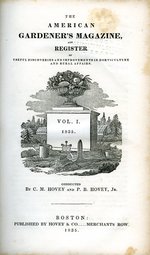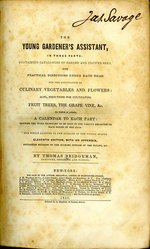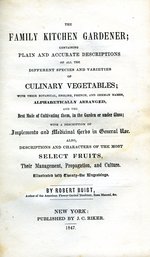To America, European settlers brought seeds and plants from their native countries and the West Indies. They also traded with Native Americans, who cultivated, among other crops, corn, beans, squash, melons and fruit trees. Seeds, plants and trees were imported from England and continental Europe to supply the colonies with familiar fruit and vegetables. Wealthy landowners and plant collectors such as Thomas Jefferson, John Bartram, and Martha Logan exchanged seeds with botanists in America and Europe. Plants and seeds were imported and sold in shops alongside other merchandise and advertised in local newspapers. In addition to raising animals and growing grain, American settlers planted vegetables and fruit trees for subsistence and herbs for medicine. Those who could afford them also grew ornamental plants.1
Most of the first seed and nursery companies in the United States were in cities along the eastern seaboard. Robert Prince established one of America’s oldest and most prominent commercial fruit tree nurseries in 1737, in Flushing, New York; the Prince Nursery’s first catalogue, which contains prices as well as ordering and shipping information, was issued in 1771. In 1784, David and Cuthbert Landreth in Philadelphia started America’s oldest seed company, which is still in business. Bernard M’Mahon, who wrote the popular book The American Gardener’s Calendar, opened his Philadelphia seed store in 1802. Most catalogues from the late eighteenth to early nineteenth century were printed broadsheets. Others, such as a catalogue by M’Mahon from 1805, were in booklet form.2 Generally, early American seed and nursery catalogues did not contain illustrations or descriptive information on individual varieties; however, some contained notes to signify annuals and perennials, or whether a variety was for early or late planting.3
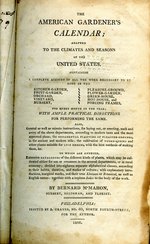
The American Gardener's Calendar; Adapted to the Climates and Season of the United States...etc. 1806.
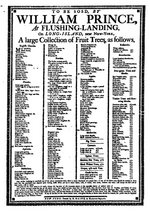
To be Sosd, By William Prince, at Flushing-Landing on Long-Island, Near New York, A Large Collection of Fruit Trees...etc. 1771. (scanned from microfiche)

A Catalogue of Garden, Grass, Herb, Flower, Tree & Shrub-Seeds, Flower Roots, &c. 1804. (scanned from microfiche)
Like M’Mahon, many other early American seedsmen and nurserymen were authors of practical gardening literature, and their books often contained catalogues of seeds and plants. While their books and magazines helped sell their products, it would be a mistake to underestimate their idealism and view them merely as merchants. The mission of these gardeners was to bring “civilization” as descended from ancient Greece, and to elevate American horticulture to the stature of European. Like John Claudius Loudon in England, they believed that everyone, regardless of social position, would benefit from a well-kept garden. Moreover, the seed and plant sellers of this period were motivated by a sincere love of plants and an excitement about the possibilities of spreading horticulture around what they saw as a new land of freedom and plenty. OSU Special Collections houses books and periodicals by influential nineteenth century seedsmen such as Bernard M’Mahon, Thomas Bridgeman, Robert Buist and C.M. Hovey that promote horticulture for all classes and provide detailed practical information.
Many American catalogues are widely available on microfiche, such as the scanned examples of the William Prince and Bernard M'Mahon catalogues included on this page.
Notes
- For information on ornamental plants grown in American gardens see Denise Wiles Adams, Restoring American Gardens: an encyclopedia of heirloom ornamental plants, 1640-1940, Portland, Timber Press, 2004 Return to text ↑
- A Catalogue of garden, herb, flower, tree, shrub and grass seeds, gardening, agricultural and botanical books, garden tools &c., sold by Bernard M’Mahon: who has likewise for sale plants of above fifty varieties of the most superior English, Irish and Scotch gooseberries, Philadelphia, William Duane, 1805 (catalogued as 1810 but the microfiche says this is mistaken), New Canaan, CT: Readex Microprint 11x15 cm., Second Series, 20629. Return to text ↑
- William Prince, To be sold by William Prince at Flushing-Landing on Long-Island near New-York, a large collection of fruit trees as follows, microfiche, New Canann, CT: Readex Microprint 11x15 cm, Early American Imprints, Second Series, 19589; A catalogue of garden,grass, herb, tree and shrub-seeds, flower-roots, &c.&c., sold by Bernard M’Mahon, seedsman, Philadelphia, William Duane, 1805, microfiche, New Canaan, CT: Readex Microprint 11x15 cm., Second Series, 6698. Return to text ↑

